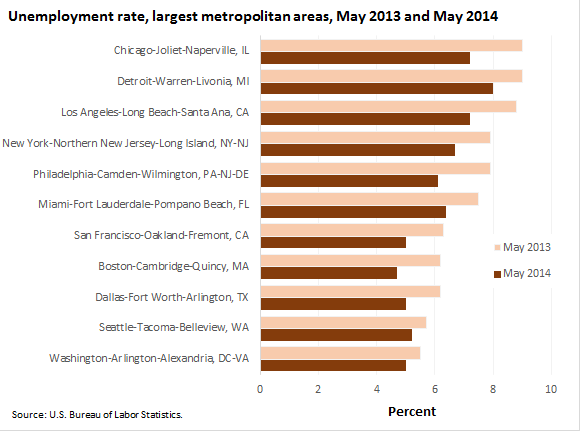An official website of the United States government
 United States Department of Labor
United States Department of Labor
Unemployment rates were lower in May than a year earlier in 357 of 372 metropolitan areas, higher in 11 areas, and unchanged in 4 areas. Twelve areas had jobless rates of at least 10.0 percent and 93 areas had rates of less than 5.0 percent. The national unemployment rate in May was 6.1 percent, not seasonally adjusted, down from 7.3 percent a year earlier.

| Metro areas | May 2013 | May 2014(p) |
|---|---|---|
Washington-Arlington-Alexandria, DC-VA | 5.5 | 5.0 |
Seattle-Tacoma-Belleview, WA | 5.7 | 5.2 |
Dallas-Fort Worth-Arlington, TX | 6.2 | 5.0 |
Boston-Cambridge-Quincy, MA | 6.2 | 4.7 |
San Francisco-Oakland-Fremont, CA | 6.3 | 5.0 |
Miami-Fort Lauderdale-Pompano Beach, FL | 7.5 | 6.4 |
Philadelphia-Camden-Wilmington, PA-NJ-DE | 7.9 | 6.1 |
New York-Northern New Jersey-Long Island, NY-NJ | 7.9 | 6.7 |
Los Angeles-Long Beach-Santa Ana, CA | 8.8 | 7.2 |
Detroit-Warren-Livonia, MI | 9.0 | 8.0 |
Chicago-Joliet-Naperville, IL | 9.0 | 7.2 |
| Footnotes:
(p) = preliminary | ||
The eleven metropolitan areas in the chart comprise the 34 most populous metropolitan divisions. Each experienced unemployment rate declines from May 2013 to May 2014, ranging from 0.5 percentage point (Washington-Arlington-Alexandria, District of Columbia-Virginia, and Seattle-Tacoma-Bellevue, Washington) to 1.8 percentage points (Chicago-Joliet-Naperville, Illinois, and Philadelphia-Camden-Wilmington, PA-NJ-DE).
Among all metropolitan areas, New Bedford, Massachusetts, had the largest unemployment rate decrease (-2.8 percentage points). Thirty-seven other areas had rate declines of at least 2.0 percentage points, and an additional 201 areas had declines of at least 1.0 point. Florence-Muscle Shoals, Alabama, had the largest over-the-year jobless rate increase (+0.4 percentage point).
These metropolitan area data are from the Local Area Unemployment Statistics program and are not seasonally adjusted. To learn more, see “Metropolitan Area Employment and Unemployment — May 2014 (HTML) (PDF), news release USDL-14-1242.
Bureau of Labor Statistics, U.S. Department of Labor, The Economics Daily, Metropolitan area unemployment in May 2014 at https://www.bls.gov/opub/ted/2014/ted_20140703.htm (visited January 11, 2026).

